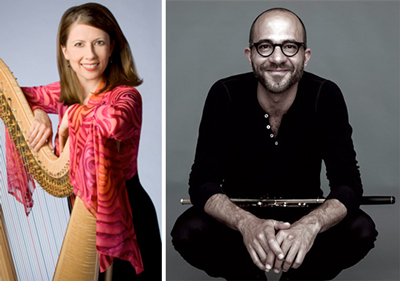by Daniel Hathaway

Wolfgang Amadè Mozart wrote exactly one piece that involved the harp, his Concerto for Flute and Harp. He was on an ultimately disappointing, seven-month visit to Paris in 1778. Given the concert-going public’s interest in double concertos, he seized the opportunity to write a work featuring the flute-playing Duke of Guînes and his harpist daughter. (A composition student of Mozart’s, she seems to have been more adept at the harp.)
The concerto is a delight to the ear, full of Mozartean grace and charm, though it must be very tricky for the harpist. Mozart essentially wrote piano music for Marie de Guînes and her successors to play, and it doesn’t fall naturally under a harpist’s fingers.
Not a hint of that difficulty came across in Thursday’s performance. Joshua Smith read from an iPad with a Bluetooth pedal for page flipping, and Yolanda Kondonassis performed on a Lyon and Healey “Salzedo” model harp whose art deco detailing fit perfectly into the decor of the Severance Hall stage. Their playing seemed effortless and sounded completely charming. Smith’s gorgeous tone sailed out robustly into the hall, and Kondonassis’s scale passages, Alberti basses, and trills (played with the thumbs!) were clean and assured.
If that iPad and modern chromatic harp seemed a bit anachronistic, so did the three cadenzas by Carl Reinecke (1824-1910), which ventured into Romantic harmonies and modulations. Though these didn’t quite match Mozart’s pristine C-Major world, Smith and Kondonassis played them with affecting lyricism. After all, cadenzas are how improvising soloists can put their own stamp on somebody else’s concerto, and slipping in the voice of another composer is another way of doing that.
British conductor Jane Glover specializes in older repertoire, but her approach is less extreme than other early music gurus who have worked with The Cleveland Orchestra. On Thursday evening, the reduced string sections sounded full and warm (vibrato permitted), and the winds sounded like their familiar selves. Textures were transparent, phrases well-shaped, and tempos lively but not super-caffeinated.
Glover opened the program with one of the first symphonies Joseph Haydn composed for the Esterházy household in 1761. Symphony No. 6, subtitled Le matin, is the first panel of a musical triptych that also includes Le midi and La nuit. All three works predate Haydn’s codification of the symphonic form into four distinct movements, Symphony No. 6 taking its cues from the concertantes of previous musical generations, where soloists or subgroups of instruments suddenly step forward for individual or section solos.
Le matin is full of these special moments. Concertmaster Peter Otto starred in most of them, but the robust Minuet also features solos for flute (Saeran St. Christopher), viola (Robert Vernon), and the wonderful-odd combination of bassoon (John Clouser) and double bass (Scott Haigh). Flute, violin, and cello solos (Mark Kosower) dart in and out of the finale, and twice the horns blare out an arresting fanfare (Michael Mayhew and Jesse McCormick — perfectly both times).
The oboe section having packed it in for the evening, the concert closed with Mozart’s Symphony No. 39, which takes on its special sonority from the key of E-flat, the predominance of clarinets and bassoons, and the addition of trumpets and timpani. Glover led an alert, finely-paced reading of the work, punctuated by Paul Yancich’s dry sticking on period-style drums. The last movement, in keeping with Glover’s perspicacious approach to this repertoire, was brisk but beautifully controlled.
Published on ClevelandClassical.com April 19, 2016.
Click here for a printable copy of this article



